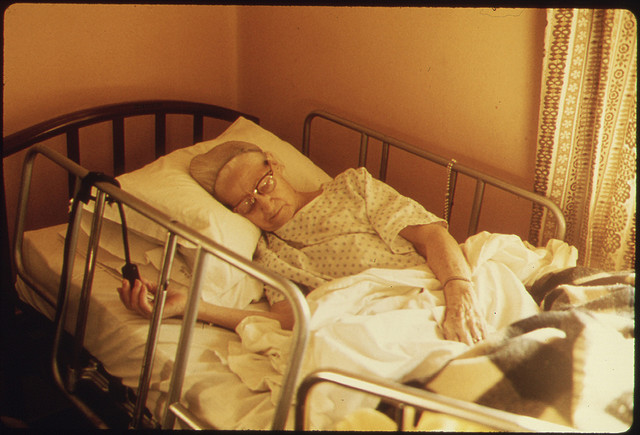
I’m hearing a lot of questions about whether someone with frailty, debility, or adult failure to thrive can still be admitted to hospice, especially since CMS will no longer beaccepting either debility or adult failure to thrive (AFTT) as a principal diagnosis on hospice claim forms starting on Oct. 1, 2014. The answer is YES and what follows is my attempt to help clarify the issue and secure my spot as a 2015 Hospice Hero (OK — I made that award up).
The Difference Between the Principle Hospice Diagnosis and Hospice Eligibility
 |
| Shaida’s Award for this Post |
The key to untangling this question is to understand the difference between the principal hospice diagnosis and hospice eligibility. These are not the same, although they are often discussed as if they were. So what is the difference?
Briefly, the principal hospice diagnosis is the diagnosis (ICD 9 Code) that the certifying hospice physician determines to be the most contributory to the patient’s terminal condition or prognosis. This is listed on the hospice claims form and hospice providers are responsible for financial coverage of medications necessary for the palliation and management of this diagnosis and related conditions.
Medicare hospice eligibility requires that the patient’s attending physician and the hospice medical director certify that the patient is terminally ill and their prognosis is for a life expectancy of 6 months or less if the terminal illness runs its normal course. CMS has guidelines called local coverage determinations (LCDs) to help physicians determine a prognosis of six months or less (and therefore determine hospice eligibility). These are guidelines to help determine prognosis and are not rules or requirements for hospice admission (the LCDs are available on the CMS.gov website). CMS states “eligibility under the Medicare Hospice Benefit is based on the prognosis of the individual and not on a single diagnosis or multiple diagnoses.” In other words, there is no forbidden diagnosis when it comes to hospice eligibility (as long as that diagnosis leads to a prognosis of six months or less), BUT debility and AFTT should not be listed as the principal diagnosis on the hospice claims form.
Why is CMS no longer accepting debility or AFTT as a principal hospice diagnosis on the claims form? CMS states these diagnoses are associated with multiple underlying conditions. Instead of listing debility or AFTT as the principal diagnosis, hospices should list the underlying conditions that have caused debility and adult failure to thrive on the claims form (as principal and additional diagnosis) and they should pay for medications necessary for the palliation and management of all these conditions.
For those of you who are thinking to yourselves “that explanation wasn’t really brief,” you are right. For those of you who would like an even more detailed answer please refer to the table 1 below —and maybe we should start an obsessive-compulsive hospice clinician support group?
A Case Example
Getting back to our question “Can Someone with Debility or Adult Failure to Thrive be Admitted to Hospice?” Lets look at a case adapted from CMS guidance:
An 85 year old patient with dysphagia, decreased oral intake, malnutrition, weight loss, BMI of 18.6 upon admission, decreasing functional status, progressed from a walker to chair to bed in less than six months, has no underlying diagnoses other than frailty and adult failure to thrive. This patient was determined to be terminally ill with a prognosis of less than 6 months by the certifying physicians.
Can this patient be enrolled in hospice? Yes. The condition the hospice physician feels is most contributory to the terminal prognosis would be reported first on the hospice claim form as the principal hospice diagnosis, along with all other related conditions. The principal and additional diagnosis could include: malnutrition, dysphagia, muscle weakness. CMS has also clarified that debility and AFTT could be listed as additional diagnoses on the claims form (just not the principal diagnosis).
How is the patient hospice eligible? He would be eligible for hospice because two doctors certified that he is terminally ill with an expected prognosis of less than 6 months. These certifying physicians could use the “adult failure to thrive syndrome” or “non-disease specific decline in clinical status” hospice LCDs as guidelines to document hospice eligibility. AFTT could be listed as an additional (not primary) hospice diagnosis as described above.
So hopefully this has shed some light on the topic, and you can continue to be a hospice hero who provides invaluable hospice care to those who need it.
by: Shaida Talebreza Brandon (@ShaidaTalebreza)

Table 1: Differences Between Hospice Principle Diagnosis and Hospice Eligibility
| • The principal diagnosis is the diagnosis (ICD 9 Code) that the certifying hospice physician determines to be the most contributory to the patient’s terminal condition • • Hospices are to report this principal • CMS expects all of a patient’s • • Hospices should not use debility or • · • |
• • • · • • Note: Palmetto, has an AFTT LCD that can be used to help determine hospice eligibility but AFTT would not be listed as the principal diagnosis on the hospice claims form. |
|
CMS |
|
|
Hospice ICD9 • |
Hospice Local • |



